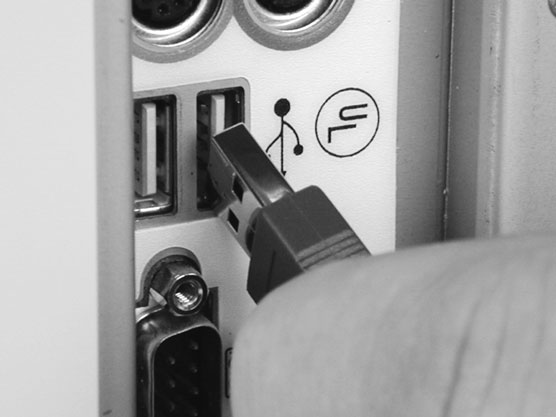- Network connections (Ethernet)
- Wireless
- Universal Serial Bus (USB)
- Infrared
Network cable connections (Ethernet)
Network-based printers have built-in network cards that allow the printer to connect directly to the network. The printer runs the TCP/IP protocol and is assigned an IP address so that it can participate on the network.You can assign the IP address to the printer through the menu system of the printer. After the IP address is assigned, you can typically manage the settings on the printer through a web browser by typing the IP address of the network printer in the address line of the browser.
Advantages of using a network-based printer are
- The network printer is available all the time. Network-based printers are connected directly to the network, so they don’t rely on a computer being powered-on to communicate with the network.
- Dedicated print servers are not required. A network printer can be accessed from anywhere in the network, and you don’t need to have a server to print to it. You may print to the network-based printer from the client computer directly.
Wireless connections
Many printers today allow you to connect the printer to the network using a wireless network connection. Many modern printers support 802.11x wireless networking capabilities. You can configure an IP address on the wireless printer (usually through software or through the menu system on the printer) and then connect to that wireless printer from any wireless or wired network client on the network.Note that 802.11x refers to any of the IEEE 802.11 WiFi protocols. The x is used in an algebraic way; namely, to serve as a variable. The x could stand for a, b, g, n, or ac.
Not only do printers support 802.11x printing capabilities, but many printers also support Bluetooth networking capabilities that allow you to connect to the printer over short distances.Universal Serial Bus (USB)
Most printers today purchased for home or small offices are USB printers that connect to the computer via a USB port (go figure). The following figure shows a USB connection. A USB connector is a popular method today to connect printers to computers.
A USB connector is a popular method today to connect printers to computers.USB has a number of benefits, including the fact that it is a Plug and Play technology (you can plug in the device without shutting down the system). USB 1.1 has a transfer rate of 12 Mbps, USB 2.0 has a transfer rate of 480 Mbps, and USB 3.0 has a transfer rate of 5 Gbps!
For reference, the following are some key points to remember about USB:
- It is Plug and Play.
- You may connect 127 devices to a USB chain.
- You don’t need to configure ports, IRQs, or DMA channels for each device.
- USB 2.0 has a transfer rate of 480 Mbps, while USB 3.0 has a transfer rate of 5 Gbps.
Lab 4-2 will give you the opportunity to practice connecting a USB print device to your computer. Lab 4-2 can be found on the companion website at www.dummies.com/go/aplusaio.
Infrared
Connecting your printer to a system by using infrared technology lets your computer communicate wirelessly with the printer in much the same way you use a TV remote to change channels without getting off the sofa. The infrared signal sent from the computer to the printer is carried as a beam of light, instructing the printer what to print.To use an infrared printer, you need both an infrared transmitter/receiver connected to your computer and an infrared printer.
The three different types of infrared devices are
- Reflective infrared: Transmitters send the signal to a central unit, which then redirects the commands to the printer. This allows a number of users to print to a single printer at one time.
- Line-of-sight infrared: With line-of-sight, the printer’s receiver must be in a direct line-of-site with the computer’s transmitter. If there is a break in the line-of-site, communication is lost.
- Scatter infrared: Scatter infrared allows the signal to bounce off walls or ceilings (or even people) all the way to the printer’s receiver. The benefit is that you don’t lose communication like you do with line-of-sight. However, scatter infrared has limited range and transmission speeds.
FireWire and SCSI
You might also find printers that connect to a system via FireWire or SCSI connections. FireWire has two versions: 400 Mbps and 800 Mbps. FireWire 800 is also known as FireWire 1394b.SCSI is another common type of printer device that you might come across with Macintosh systems. Most PC-based systems don’t use SCSI printers, although it is possible. For more information on SCSI devices, check out Book 2, Chapter 5.
Hardware print server
In environments where a large number of print requests are happening on the network, the company may invest in a hardware print server as opposed to sharing the printer off a Windows system.The benefit of a dedicated hardware print server is speed. Using a Windows system as a print server usually means the system is used for other tasks as well. The other tasks will slow down the printing environment as they use up the resources on the system.




